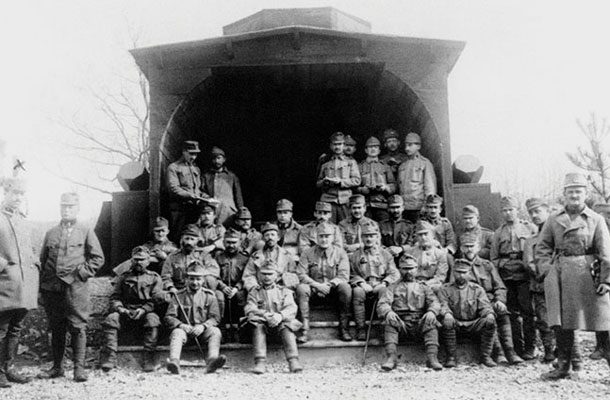EDJC 2023 > Opening of the exhibition Jewish Soldiers of The Austro-Hungarian Empire on the Isonzo Front
Opening of the exhibition Jewish Soldiers of The Austro-Hungarian Empire on the Isonzo Front

Opening of the exhibition Jewish Soldiers of The Austro-Hungarian Empire on the Isonzo Front
In 2024, we will commemorate the centenary of the start of the First World War.
Twenty years later, the Second World War followed, so the first has not been treated to the extent that would have been important and necessary. As many Jews lived in Prekmurje at the turn of the 19th century, they also had to go to war: some of them became officers. The data on them is not yet definitive and is also unreliable, so we do not know how many of them were victims or how many died.The First World War involved no less than 36 countries. The bloody fighting at the Battle of Isonzo (1915-1917) thus bore a multinational as well as a multi-religious stamp. Jews were among the many soldiers of the Austro-Hungarian and Italian armies. Jewish officers also took part in this war, which, if we recall the Dreyfus affair, was not a given. But Emperor Franz Joseph I considered Jews to be his most loyal subjects, and the Austro-Hungarian Jews themselves repeatedly referred to the Emperor as a “fortress of tolerance”. By the outbreak of the First World War, only two Jews had reached the rank of general in the Austro-Hungarian army, and during the war three more Jewish officers became generals, among them Major-General Maximilian Maendl von Bughardt (1860-1929), who distinguished himself on the Soča front. Jewish soldiers in front of the wooden synagogue on the Doberdob plateau, 1915.
Scattered in various lands and cities, there were about 1.5 million Jews (4.6 per cent of the population) in the Austro-Hungarian Empire before World War I. In 1911, there were only 109 Jews among the active officers of the (joint) Austro-Hungarian army, which represented 0.6 per cent of the entire officer corps. There were slightly more of them among the reserve officers, and proportionally more among the military doctors and in the military administrative services. A higher percentage of Jewish officers served in the Hungarian Honved. The smallest number was in the cavalry. According to previous estimates, around 300,000 Jewish soldiers fought in the Imperial Royal Army in 1914-1918. Only the Russian Tsarist army enlisted more Jewish soldiers, around half a million. The heavy losses among officers in the first year of the war led to a large increase in the number of Jewish officers, as they joined from the reserve, in which the above-average Jewish presence was mainly a reflection of their higher education. Jewish soldiers on the battlefield. Jewish soldiers were present in greater or lesser numbers in most regiments of the Austro-Hungarian army that fought on the front, most of them in units coming from the central and north-eastern part of the monarchy. Spiritual care of the soldiers. In 1918, as many as 76 military rabbis served in the Austro-Hungarian army. Among other things, their duties included censoring letters written in Hebrew from the front.
There were synagogues at the front as well as in the rear of the front, including the emergency synagogue in Maribor in 1917. There was also an improvised synagogue in Novo mesto. Military cemeteries with buried Jewish soldiers and instructions from the Soča army for the burial of fallen Jewish soldiers. In 1915, the command of the 5th Army of the Soca issued special regulations for the burial of fallen soldiers, including rules for fallen Jewish soldiers. The military Jewish graves had to be arranged in a uniform manner. The Jewish tombstone of stone was to be replaced by a wooden plaque about 20 cm wide and 70 cm high, rounded at the top. It was to have a Star of David on the top and, below, the Ten Commandments (I-V and VI-X) written in Roman numerals in two sections. The tombstone was also to bear an inscription with the name, rank, military unit and date of death. At the bottom was added the inscription ‘may he rest in peace’ or the appropriate saying in Hebrew script. According to military statistics and estimates, around 40 000 Jewish soldiers died during the First World War, of whom around 1 000 were officers. How many died on the Isonzo front can only be guessed at present.
(The text is adapted from an exhibition by dr. Renato Podbersič from the Study Centre for National Reconciliation and Dr Petra Svoljšak from the Scientific Research Centre of SAZU)
End Date: 01/09/2025
6:00 pm - 8:00 pm
Exhibition
Križevniška ulica 3,
Ljubljana, Slovenia
1000
Face-to-Face
Jewish Centre Ljubljana

